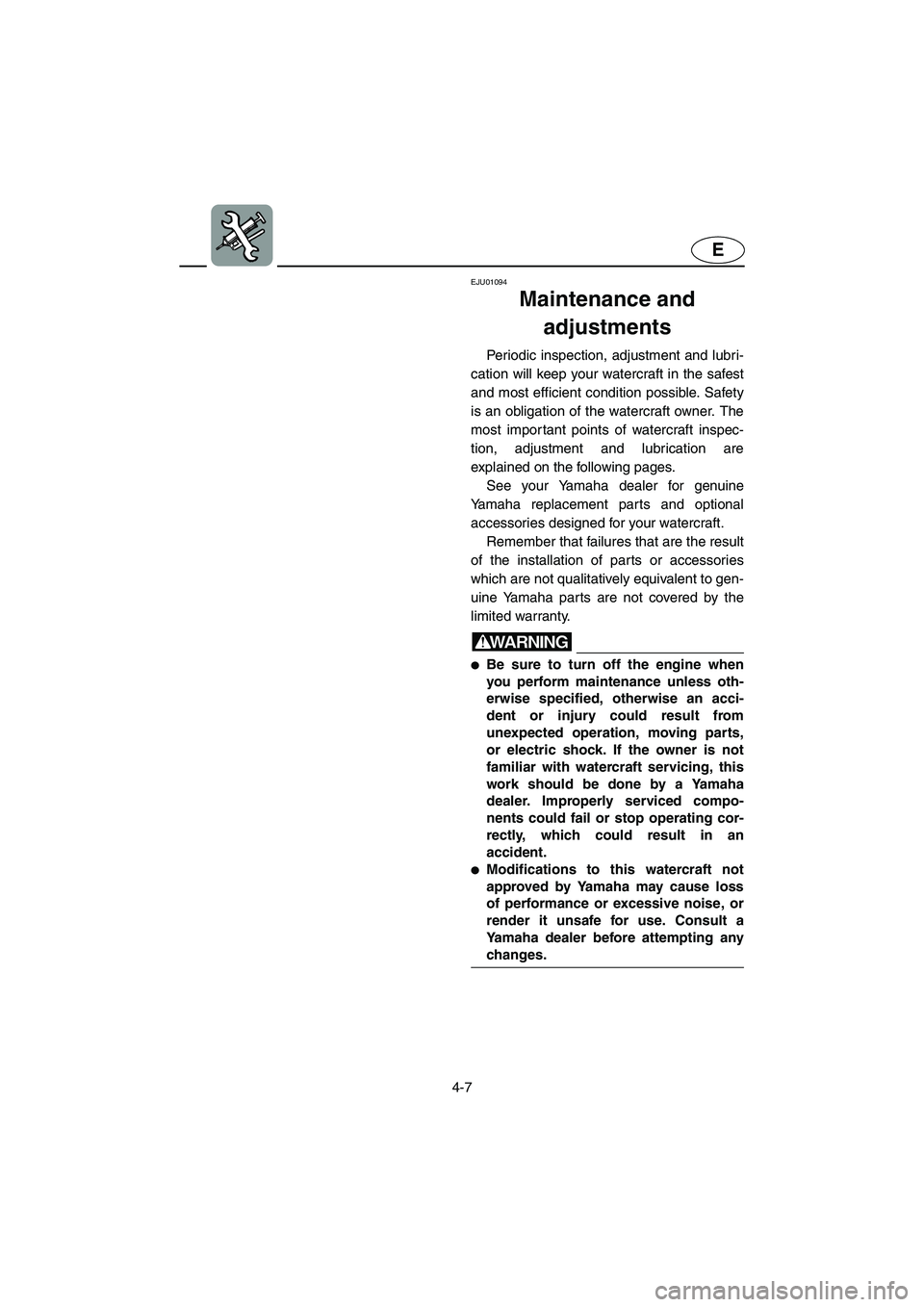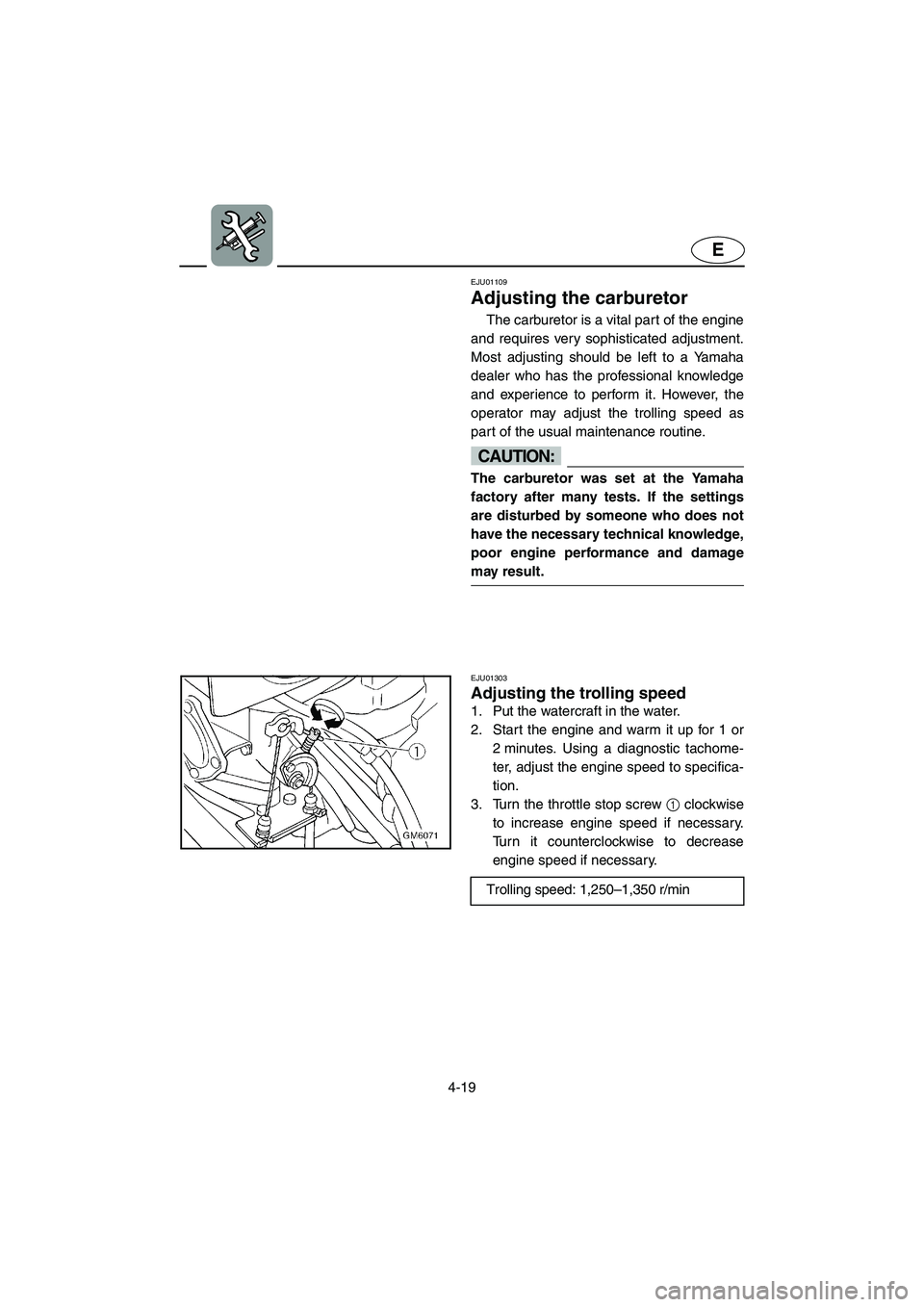Page 75 of 106

4-6
E
CAUTION:@ The battery may be impossible to use
again if you store it for a longer time
without recharging. Recharge the battery
periodically.
@
NOTE:@ The battery condition can be found by
checking the specific gravity of the electro-
lyte. However, you can also know the battery
condition roughly by measuring the voltage
at both battery terminals. Recharge the bat-
tery if the voltage is 12 volts or less.
Yamaha recommend checking the specific
gravity of the electrolyte and charging bat-
tery by a Yamaha dealer or a battery dealer.
If you maintain the battery yourself, read
carefully the instructions for the tool and
machine before maintenance.
@
EJU01300
Cleaning the watercraft
Clean the watercraft before storing it for a
long period.
1. Wash down the hull, handlebars, and
drive unit with fresh water.
2. Rinse the engine and bilge area with
fresh water. Drain off all water and wipe
up remaining moisture with clean, dry
rags.
3. Spray the engine’s exterior with a rust
inhibitor and lubricant.
4. Wax the hull with a non-abrasive wax.
5. Wipe all vinyl and rubber components,
such as the engine compartment seals,
with a vinyl protectant.
6. Do not use protectant on the riding tray,
because it will make it slippery. Specific gravity of electrolyte
(for reference):
1.28 at 20 °C (68 °F)
E_F1N-70.book Page 6 Wednesday, July 18, 2001 3:28 PM
Page 76 of 106

4-7
E
EJU01094
Maintenance and
adjustments
Periodic inspection, adjustment and lubri-
cation will keep your watercraft in the safest
and most efficient condition possible. Safety
is an obligation of the watercraft owner. The
most important points of watercraft inspec-
tion, adjustment and lubrication are
explained on the following pages.
See your Yamaha dealer for genuine
Yamaha replacement parts and optional
accessories designed for your watercraft.
Remember that failures that are the result
of the installation of parts or accessories
which are not qualitatively equivalent to gen-
uine Yamaha parts are not covered by the
limited warranty.
WARNING@ �Be sure to turn off the engine when
you perform maintenance unless oth-
erwise specified, otherwise an acci-
dent or injury could result from
unexpected operation, moving parts,
or electric shock. If the owner is not
familiar with watercraft servicing, this
work should be done by a Yamaha
dealer. Improperly serviced compo-
nents could fail or stop operating cor-
rectly, which could result in an
accident.
�Modifications to this watercraft not
approved by Yamaha may cause loss
of performance or excessive noise, or
render it unsafe for use. Consult a
Yamaha dealer before attempting any
changes.
@
E_F1N-70.book Page 7 Wednesday, July 18, 2001 3:28 PM
Page 79 of 106
4-10
E
EJU01383
Inspecting the fuel system
WARNING@ Gasoline is highly flammable and explo-
sive. A fire or explosion can cause
severe injury or death. Shut off the
engine. Do not smoke. Avoid spilling
gasoline.
@
Check the fuel system for leaks, cracks,
or malfunctions. If any problem is found, do
the necessary repair or replacement as
required. If repair is necessary, consult a
Yamaha dealer.
Check:
�Carburetor for leakage.
�Fuel pump for malfunction or leakage.
�Fuel tank for water or dirt.
�Fuel tank for damage, cracks or leakage.
�Fuel hose joint for leakage.
�Fuel hose for cracks or other damage.
�Fuel filter for leakage.
�Fuel cock for leakage.
�Air vent check valve for leakage.
�Fuel tank filler cap for damage.
WARNING@ Failure to check for and repair any fuel
leakage may result in fire or explosion.
@
E_F1N-70.book Page 10 Wednesday, July 18, 2001 3:28 PM
Page 82 of 106

4-13
E
EJU01343
Cleaning and adjusting the
spark plugs
The spark plug is an important engine
component and is easy to inspect. The con-
dition of the spark plug can indicate some-
thing about the condition of the engine. For
example, if the center electrode porcelain is
very white, this could indicate an intake air
leak or carburetion problem in that cylinder.
Do not attempt to diagnose any problems
yourself. Have a Yamaha dealer service the
watercraft.
Remove and inspect the spark plug peri-
odically; heat and deposits will cause the
spark plug to slowly break down and erode.
If electrode erosion becomes excessive, or if
carbon and other deposits are excessive,
replace the spark plug with the specified
plug.
Measure the spark plug gap a with a
wire thickness gauge before installing the
spark plug. Adjust the gap to specification if
necessary.
To reinstall spark plug:
1. Clean the gasket surface.
2. Wipe any dirt from the threads of the
spark plug.
3. Screw the spark plug to the correct
torque. Standard spark plug:
BR7HS
Spark plug gap:
0.6–0.7 mm (0.024–0.028 in)
Spark plug torque:
25 N·m (2.5 kgf·m, 18 ft·lb)
E_F1N-70.book Page 13 Wednesday, July 18, 2001 3:28 PM
Page 88 of 106

4-19
E
EJU01109
Adjusting the carburetor
The carburetor is a vital part of the engine
and requires very sophisticated adjustment.
Most adjusting should be left to a Yamaha
dealer who has the professional knowledge
and experience to perform it. However, the
operator may adjust the trolling speed as
part of the usual maintenance routine.
CAUTION:@ The carburetor was set at the Yamaha
factory after many tests. If the settings
are disturbed by someone who does not
have the necessary technical knowledge,
poor engine performance and damage
may result.
@
EJU01303
Adjusting the trolling speed
1. Put the watercraft in the water.
2. Start the engine and warm it up for 1 or
2 minutes. Using a diagnostic tachome-
ter, adjust the engine speed to specifica-
tion.
3. Turn the throttle stop screw 1 clockwise
to increase engine speed if necessary.
Turn it counterclockwise to decrease
engine speed if necessary.
Trolling speed: 1,250–1,350 r/min
E_F1N-70.book Page 19 Wednesday, July 18, 2001 3:28 PM
Page 92 of 106

4-23
E
EJU01359
Specifications
*1: Pump Octane Number
*2: Research Octane NumberMODEL
ITEMUnit SJ700
WATERCRAFT CAPACITY
Maximum people on board Number of people 1
DIMENSIONS
Length mm (in) 2,240 (88.2)
Width mm (in) 680 (26.8)
Height mm (in) 660 (26.0)
Dry weight kg (lb) 132 (291)
PERFORMANCE
Maximum power output kW (PS) @ r/min 53.7 (73) @ 6,300
Maximum fuel consumption L/h (US gal/h, Imp gal/h) 29 (7.7, 6.4)
Cruising range at full throttle hr. 0.6
Trolling speed r/min 1,250–1,350
ENGINE
Engine type 2-stroke
Number of cylinders 2
Engine displacement
cm
3 (cu in)701 (42.78)
Bore & stroke mm (in) 81 ×
68 (3.19 ×
2.68)
Compression ratio 7.2
Lubrication system Pre-mixed fuel
Cooling system Water cooled
Starting system Electric starter
Ignition system CDI
Spark plug BR7HS (NGK)
Spark plug gap mm (in) 0.6–0.7 (0.024–0.028)
Battery capacity V-AH 12-19
Charging system Flywheel magneto
DRIVE UNIT
Propulsion system Jet pump
Jet pump type Axial flow, single stage
Impeller rotation Counterclockwise (viewed from rear)
Transmission Direct drive from engine
Jet thrust nozzle angle Degree 37, 41, 45, 49
FUEL AND OIL
Recommended fuel Regular unleaded gasoline
Minimum octane rating PON (*1)
RON (*2)86
90
Recommended engine oil YAMALUBE 2-W, or an equivalent NMMA-
certified TC-W3 marine oil
Fuel mixing ratio (fuel to oil) 50:1
Fuel tank capacity
Total L (US gal, Imp gal) 18 (4.8, 4.0)
Reserve L (US gal, Imp gal) 5.5 (1.45, 1.21)
E_F1N-70.book Page 23 Wednesday, July 18, 2001 3:28 PM
Page 94 of 106

5-1
E
EJU01116
Troubleshooting
If you have any trouble with your watercraft, use this section to check for the possible
cause.
If you cannot find the cause, or if the procedure for replacement or repair is not described
in this Owner’s/Operator’s Manual, have a Yamaha dealer perform the necessary service.
EJU01367
Troubleshooting chart
TROUBLE POSSIBLE CAUSE REMEDY PAGE
Engine does not
startStarter motor does not turn over
Engine shut-
off switch Clip not in place Install clip
2-5
Fuse Burned out Replace fuse and check
wiring4-20
Battery Run down Recharge 4-18
Poor terminal connec-
tionsTighten as required
4-18
Starter motor Faulty Have serviced by
Yamaha dealer—
Starter motor turns over
Fuel cock Turned to “OFF”Turn fuel cock knob to
“ON”2-4
Fuel Empty Refill as soon as possi-
ble3-4
Stale or contaminated Have serviced by
Yamaha dealer4-10
Fuel tank Water or dirt present Have serviced by
Yamaha dealer4-11
Spark plug Fouled or defective Clean or replace 4-13
Spark plug cap Not connected or loose Connect properly 4-13
Crankcase Filled with water Crank engine with plug
out until clean5-7
Fuel filter Clogged or water
pooledHave serviced by
Yamaha dealer4-11
Choke Knob moves back on
its ownTighten choke knob
adjusting nut4-16
E_F1N-70.book Page 1 Wednesday, July 18, 2001 3:28 PM
Page 95 of 106

5-2
E
Engine runs irregu-
larly or stallsFuel Empty Refill as soon as possi-
ble3-4
Stale or contaminated Have serviced by
Yamaha dealer4-10
Too much oil in fuel
mixing ratioCorrect fuel-to-oil ratio
to 50:13-3
Choke Knob is left pulled Push fully in 2-6
Fuel filter Clogged or water
pooledHave serviced by
Yamaha dealer4-11
Fuel tank Water or dirt present Have serviced by
Yamaha dealer4-11
Spark plug Fouled or defective Replace 4-13
Incorrect heat range Replace 4-13
Gap incorrect Adjust 4-13
Spark plug cap Loose Connect properly 4-13
Cracked, torn or dam-
agedReplace
4-13
Electrical wir-
ingLoose electrical con-
nectionsTighten or connect
properly—
Carburetor Incorrect idle adjust-
mentAdjust idle
4-19
Clogged Have serviced by
Yamaha dealer4-19
Wate rcr af t slow or
loses powerCavitation Jet intake clogged Clean 5-3
Impeller damaged or
wornHave serviced by
Yamaha dealer5-3
Engine over-
heatedJet intake clogged Clean
5-3
Fuel filter Clogged Have serviced by
Yamaha dealer4-11
Spark plug Fouled or defective Replace 4-13
Incorrect heat range Replace 4-13
Gap incorrect Adjust 4-13
Spark plug
capsLoose Connect properly
4-13
Fuel Stale or contaminated Have serviced by
Yamaha dealer4-10 TROUBLE POSSIBLE CAUSE REMEDY PAGE
E_F1N-70.book Page 2 Wednesday, July 18, 2001 3:28 PM